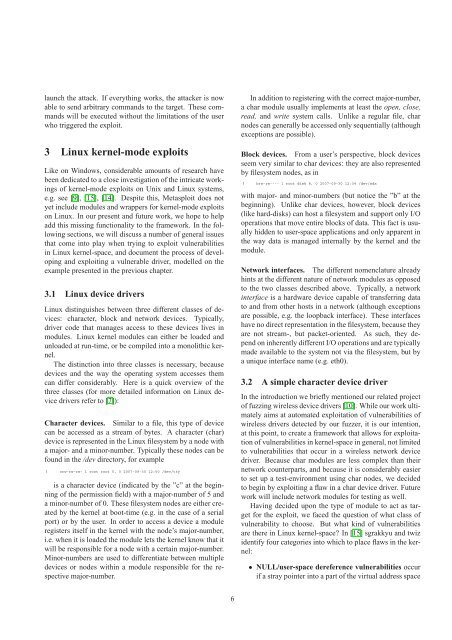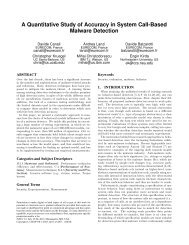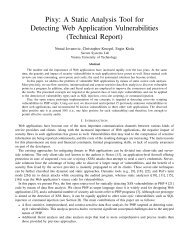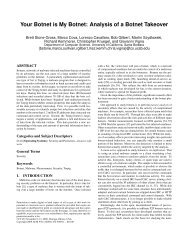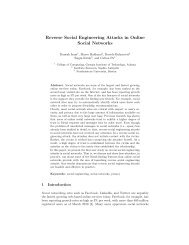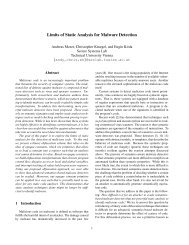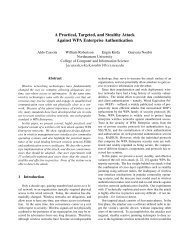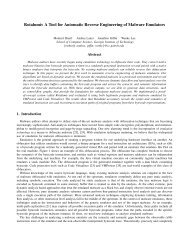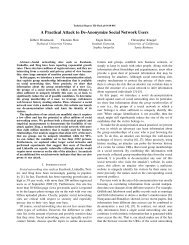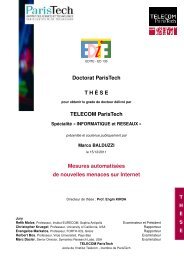Kernel-mode exploits primer - International Secure System Lab
Kernel-mode exploits primer - International Secure System Lab
Kernel-mode exploits primer - International Secure System Lab
Create successful ePaper yourself
Turn your PDF publications into a flip-book with our unique Google optimized e-Paper software.
launch the attack. If everything works, the attacker is nowable to send arbitrary commands to the target. These commandswill be executed without the limitations of the userwho triggered the exploit.3 Linux kernel-<strong>mode</strong> <strong>exploits</strong>Like on Windows, considerable amounts of research havebeen dedicated to a close investigation of the intricate workingsof kernel-<strong>mode</strong> <strong>exploits</strong> on Unix and Linux systems,e.g. see [9], [15], [14]. Despite this, Metasploit does notyet include modules and wrappers for kernel-<strong>mode</strong> <strong>exploits</strong>on Linux. In our present and future work, we hope to helpadd this missing functionality to the framework. In the followingsections, we will discuss a number of general issuesthat come into play when trying to exploit vulnerabilitiesin Linux kernel-space, and document the process of developingand exploiting a vulnerable driver, <strong>mode</strong>lled on theexample presented in the previous chapter.3.1 Linux device driversLinux distinguishes between three different classes of devices:character, block and network devices. Typically,driver code that manages access to these devices lives inmodules. Linux kernel modules can either be loaded andunloaded at run-time, or be compiled into a monolithic kernel.The distinction into three classes is necessary, becausedevices and the way the operating system accesses themcan differ considerably. Here is a quick overview of thethree classes (for more detailed information on Linux devicedrivers refer to [7]):Character devices. Similar to a file, this type of devicecan be accessed as a stream of bytes. A character (char)device is represented in the Linux filesystem by a node witha major- and a minor-number. Typically these nodes can befound in the /dev directory, for example1 crw-rw-rw- 1 root root 5, 0 2007-09-30 12:50 /dev/ttyis a character device (indicated by the ”c” at the beginningof the permission field) with a major-number of 5 anda minor-number of 0. These filesystem nodes are either createdby the kernel at boot-time (e.g. in the case of a serialport) or by the user. In order to access a device a moduleregisters itself in the kernel with the node’s major-number,i.e. when it is loaded the module lets the kernel know that itwill be responsible for a node with a certain major-number.Minor-numbers are used to differentiate between multipledevices or nodes within a module responsible for the respectivemajor-number.In addition to registering with the correct major-number,a char module usually implements at least the open, close,read, and write system calls. Unlike a regular file, charnodes can generally be accessed only sequentially (althoughexceptions are possible).Block devices. From a user’s perspective, block devicesseem very similar to char devices: they are also representedby filesystem nodes, as in1 brw-rw---- 1 root disk 8, 0 2007-09-30 12:34 /dev/sdawith major- and minor-numbers (but notice the ”b” at thebeginning). Unlike char devices, however, block devices(like hard-disks) can host a filesystem and support only I/Ooperations that move entire blocks of data. This fact is usuallyhidden to user-space applications and only apparent inthe way data is managed internally by the kernel and themodule.Network interfaces. The different nomenclature alreadyhints at the different nature of network modules as opposedto the two classes described above. Typically, a networkinterface is a hardware device capable of transferring datato and from other hosts in a network (although exceptionsare possible, e.g. the loopback interface). These interfaceshave no direct representation in the filesystem, because theyare not stream-, but packet-oriented. As such, they dependon inherently different I/O operations and are typicallymade available to the system not via the filesystem, but bya unique interface name (e.g. eth0).3.2 A simple character device driverIn the introduction we briefly mentioned our related projectof fuzzing wireless device drivers [10]. While our work ultimatelyaims at automated exploitation of vulnerabilities ofwireless drivers detected by our fuzzer, it is our intention,at this point, to create a framework that allows for exploitationof vulnerabilities in kernel-space in general, not limitedto vulnerabilities that occur in a wireless network devicedriver. Because char modules are less complex than theirnetwork counterparts, and because it is considerably easierto set up a test-environment using char nodes, we decidedto begin by exploiting a flaw in a char device driver. Futurework will include network modules for testing as well.Having decided upon the type of module to act as targetfor the exploit, we faced the question of what class ofvulnerability to choose. But what kind of vulnerabilitiesare there in Linux kernel-space? In [15] sgrakkyu and twizidentify four categories into which to place flaws in the kernel:• NULL/user-space dereference vulnerabilities occurif a stray pointer into a part of the virtual address space6


